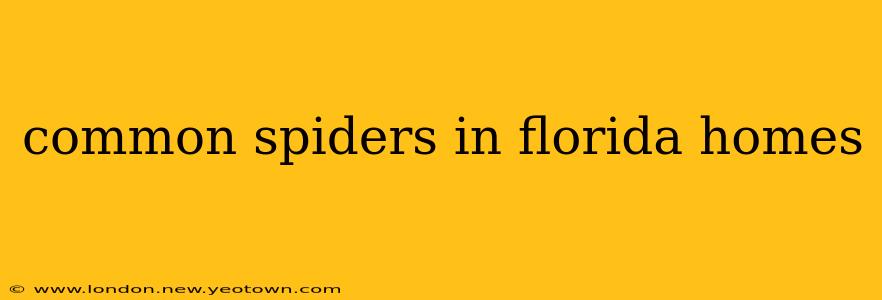Florida's warm, humid climate provides a haven for a diverse range of spiders, many of which find their way into our homes. While most are harmless, understanding the common species can alleviate concerns and help you manage any potential infestations. This guide explores the spiders frequently encountered in Florida residences, focusing on identification, behavior, and how to deal with their presence.
Identifying Common Florida House Spiders
Several spider species are particularly prevalent in Florida homes. Let's delve into some of the most frequently seen:
1. American House Spider (Parasteatoda tepidariorum)
- Appearance: Small to medium-sized, with a light brown to grayish body. Their abdomens often have mottled markings. They typically have a round abdomen and relatively long legs.
- Behavior: These spiders build messy, three-dimensional webs in dark, undisturbed corners, closets, and garages. They are generally shy and non-aggressive.
- Venom: Their venom is considered harmless to humans; a bite may cause mild, localized irritation.
2. Black Widow Spider (Latrodectus mactans)
- Appearance: Easily recognizable by the shiny, black body and distinctive red hourglass marking on the underside of the abdomen. Females are significantly larger than males.
- Behavior: They prefer dark, secluded spaces like woodpiles, sheds, and under eaves. They build irregular webs that are often sticky and messy.
- Venom: Black widow venom is neurotoxic and can cause painful muscle cramps, nausea, and other symptoms. A bite necessitates medical attention. This is one of the few spiders in Florida to be considered medically significant.
3. Brown Recluse Spider (Loxosceles reclusa)
- Appearance: Though not as common in Florida as in other states, they are sometimes found. They are characterized by a dark brown violin-shaped marking on their cephalothorax (the fused head and chest region).
- Behavior: Prefer dark, undisturbed areas and often hide in cracks and crevices. They build irregular webs.
- Venom: Brown recluse venom is cytotoxic, causing tissue damage at the bite site. Medical attention is recommended. Another spider in Florida that warrants caution.
4. Jumping Spiders (Salticidae)
- Appearance: Small to medium-sized with robust bodies and excellent eyesight. They exhibit a wide range of colors and patterns.
- Behavior: Active hunters, they don't build webs but stalk and pounce on their prey. Often found on walls and windows.
- Venom: Their venom is generally harmless to humans, though a bite might cause minor irritation.
5. Orb Weavers (various species)
- Appearance: A diverse group of spiders known for their intricate, circular webs. They vary significantly in size and coloration. Common garden orb-weavers are often seen near lights at night.
- Behavior: They construct large, beautiful, wheel-shaped webs to catch their prey. Typically found outdoors but may venture indoors accidentally.
- Venom: Their venom is generally not harmful to humans.
Managing Spider Populations in Your Home
While most spiders are beneficial in controlling insect populations, excessive numbers can be unsettling. Here are some preventative measures:
- Cleanliness: Regularly clean and vacuum your home, paying attention to corners, crevices, and cluttered areas.
- Seal Entry Points: Caulk cracks and gaps in walls, windows, and foundations to prevent spiders from entering.
- Reduce Clutter: Cluttered areas provide ideal hiding places for spiders.
- Outdoor Lighting: Minimize outdoor lighting as it attracts insects, which in turn attract spiders.
Important Note: If you encounter a black widow or brown recluse, it's best to contact a pest control professional for removal. While bites are rare, their venom necessitates medical attention.
Conclusion: Coexisting with Florida Spiders
Understanding the common spiders found in Florida homes allows for informed coexistence. While some species require caution, most pose minimal threat to humans. By implementing preventative measures and recognizing the spiders present, you can minimize encounters and maintain a comfortable living environment. Remember, if you're unsure about the identity of a spider, it's always best to err on the side of caution and contact pest control if you are uncomfortable handling them yourself.

